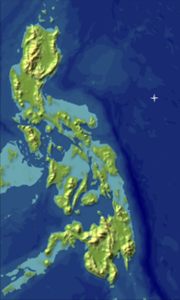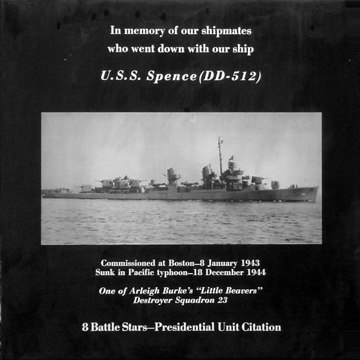

Spence was lost in a typhoon 380 nautical miles east of Manila, 18 December 1944.
“Each time I hear the name USS Spence, I feel like a mother who has lost her first born and, being a sentimentalist, I shed a tear . . . ”
— Rear Admiral Henry A. Armstrong, Spence’s first commanding officer.
Laid down at Bath Iron Works 18 May 1942 and named for an early 19th century naval officer, Spence was commissioned 8 January 1943, the 32nd ship of the 2,100-ton Fletcher class.
After shakedown in the West Indies and a convoy escort run to Casablanca, April–May 1943, Spence passed through the Panama Canal in June and saw her first action in the Pacific war supporting landings at Baker Island in September.
Arriving in the Solomon Islands later that month, Spence helped destroy 20 Japanese barges off Vella Lavella 1–2 October, then was attached to Destroyer Squadron 23 under Capt. Arleigh Burke as flagship of Cmdr. B. L. “Count” Austin’s Destroyer Division 46 (with Thatcher, Converse and Foote).
Operating with of Adm. “Tip” Merrill’s Task Force 39, Spence and her squadron screened cruisers Montpelier, Cleveland, Columbia and Denver in bombarding airfields at Buka and Bonis in northern Bougainville preceding landings at that island’s Empress Augusta Bay, 1 November.
At the Battle of Empress Augusta Bay that night, Spence and Thatcher, which had misunderstood a turn command, scraped past one another at a combined speed of 60 knots. Later in the battle, Spence received a shell hit below the waterline, contaminating fuel oil and reducing her speed, but continued her attack with Thatcher and Converse, launching torpedoes at fleeing enemy destroyers.
With Thatcher and Foote damaged, DesDiv 46 was reduced to Converse and Spence for the Thanksgiving Battle of Cape St. George, where they finished off destroyer Makinami. (For this action, Spence had only three boilers in commission, restricting her expected top speed to 31 knots. When the commodore passed on this news to Adm. Halsey’s staff, they used it in padding their reply and it became his nickname: “31-knot” Burke.)
Following additional operations in the Solomon and Bismarck Islands, for which ships present in the squadron received the Presidential Unit Citation after the war, Spence operated off New Guinea and participated in bombardments of Truk and Ponape in the Caroline Islands.

Memorial Wall plaque
National Museum of the Pacific War,
Fredericksburg, Texas.
Spence also screened carriers for during air strikes and the occupation of the Marianas, including the Battle of the Philippine Sea (the “Marianas Turkey Shoot”), in June and July. In August, she sailed for San Francisco for a six-week overhaul at Hunter’s Point and trials, departing 5 October.
In November, Spence joined Task Force 38.1 (Wasp, Yorktown, Cowpens and Intrepid) operating from Ulithi, nearly colliding with Wasp when her rudder jammed during refueling, 12 November. On 10 December, with her task force, Spence departed Ulithi for air strikes against Luzon.
One week later, Spence prepared to refuel and pumped out all salt water ballast from her tanks, but this operation was postponed due to heavy seas, breaking fuel lines and a near-collision with Adm. Halsey’s flagship New Jersey. The next day, 18 December, the weather built into a typhoon. At about noon, Spence’s rudder again jammed. Caught with insufficient ballast for the extreme conditions, she capsized and sank. Only 24 shipmates, all topsides crew, survived to be rescued by USS Tabberer (DE 418), which also picked up survivors of Hull.
In addition to DesRon 23’s Presidential Unit Citation, Spence earned 8 battle stars.